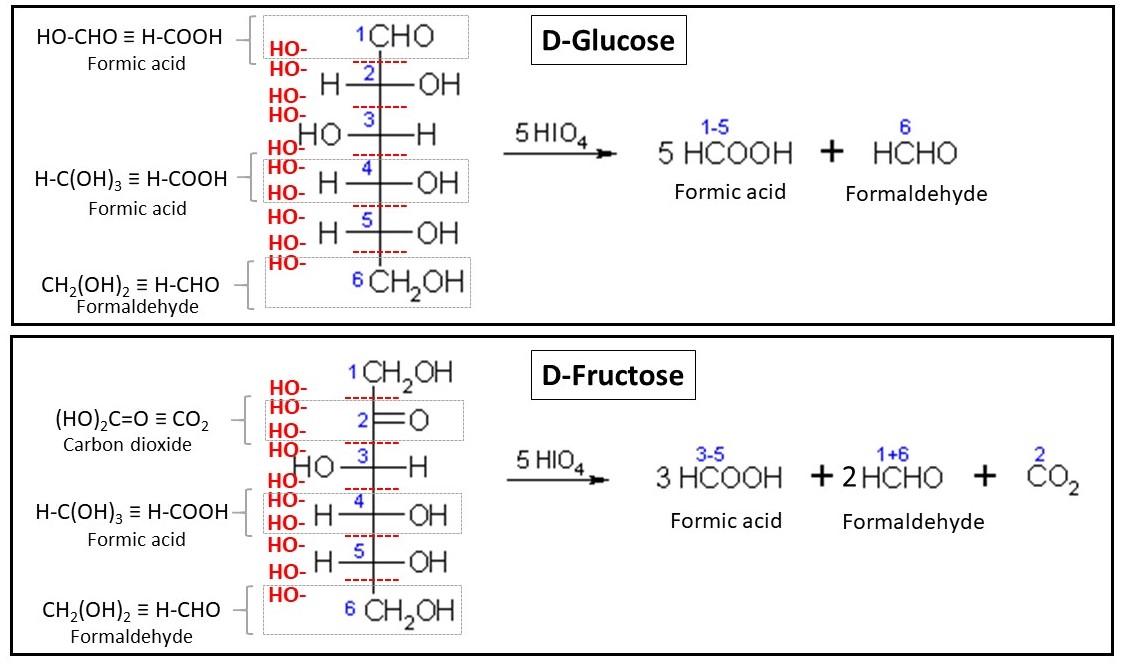In 1928, Malaprade demonstrated that periodic acid reacted with ethylene glycol to produce iodic acid and formaldehyde (Ref.1). Hence, the oxidation of adjacent diols with periodic acid or its salt in aqueous solution is now generally known as the Malaprade reaction, the mechanism of which is depicted below:

The reaction proceeds faster under acidic conditions and can be applied to higher polyhydric alcohols, which behave similar to ethylene glycol. The necessity for the reaction is to have 1,2-dihydroxy functionality $\left(\ce{>C^1(OH)-C^2(OH)<}\right)$, and upon exposer to periodic acid, the middle $\ce{C^1\!-C^2}$ bond would oxidatively cleave to give two compounds with gem-diol functionality $\left(\ce{>C^1(OH)2 \ and \ (OH)2C^2<}\right)$, which are essentially carbonyl groups in aqueous solutions. The reaction has also been further extended to the cleavage of α‐hydroxy carbonyl compounds, 1,2‐dicarbonyl compounds, α‐amino alcohols, α‐amino acids, and polyhydroxy alcohols since then, and successfully applied for structural analysis specifically of sugars:
 (source, Ref.2)
(source, Ref.2)
As shown in the figure, each $\ce{C-C}$ oxidative cleavage of $\ce{C-C}$ bond gives $\ce{OH}$ group to each carbon. For example, 1,2-bond chevage between $\ce{-CH(OH)-CHO}$ gives aldehyde carbon another $\ce{OH}$ group, making it formic acid as shown in the diagram. Meanwhile, 1,2- and 2,3-bond cleavages gives $\ce{C}$2 carbon two extra $\ce{OH}$ groups so that resultant molecule is formic acid again. Thus, complete oxidation of $\pu{1 mol}$ of D-glucose gives $\pu{5 mol}$ of formic acid and $\pu{1 mol}$ of formaldehyde.
The requirement is to have 1,2-diol functionality. So, how ketone and aldehyde with $\alpha$-hydroxy groups get oxidized? In aqueous solutions, ketones and aldehydes are in equilibrium with their corresponding gem-diols, thus providing 1,2-diol feature.
The 1,2-diol does not have to be cis-orientation. The trans-diol will also get oxidized but with slower rate (see here and Ref.3).
References:
- Zerong Wang, "Malaprade Reaction (Malaprade Oxidation)," In Comprehensive Organic Name Reactions and Reagents; John Wiley & Sons, Inc.: New York, NY, 2010 (https://doi.org/10.1002/9780470638859.conrr406). ISBN: 9780471704508.
- Fathia Mohammed Ibrahim, Mubark Elsayed Osman, "Elucidation of Sugars Structure through Periodic Acid Oxidation Cleavage," International Journal of Science and Research (IJSR) 2018, 7(1), 1152-1155 (https://www.ijsr.net/search_index_results_paperid.php?id=6121702)(PDF)
- G. J. Buist, C. A. Bunton, J. H. Miles, “149. The mechanism of oxidation of α-glycols by periodic acid. Part V. Cyclohexane-1 : 2-diols,” J. Chem. Soc. 1959, 743-748 (https://doi.org/10.1039/JR9590000743).


